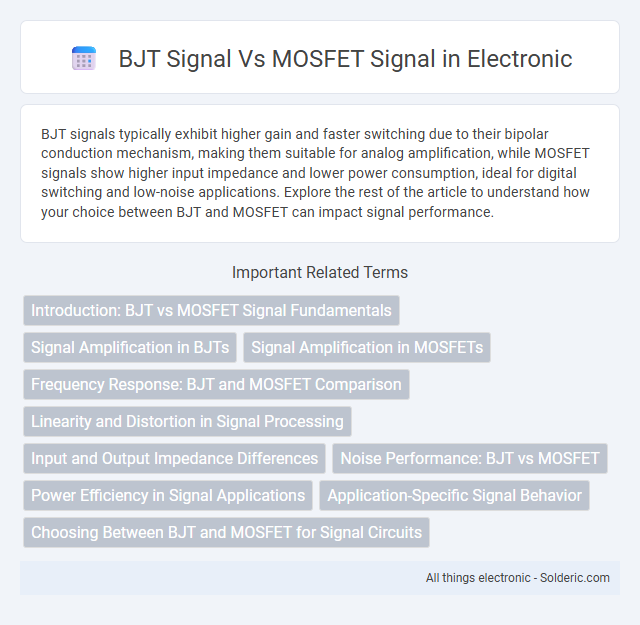BJT signals typically exhibit higher gain and faster switching due to their bipolar conduction mechanism, making them suitable for analog amplification, while MOSFET signals show higher input impedance and lower power consumption, ideal for digital switching and low-noise applications. Explore the rest of the article to understand how your choice between BJT and MOSFET can impact signal performance.
Comparison Table
| Feature | BJT Signal | MOSFET Signal |
|---|---|---|
| Device Type | Current-controlled bipolar junction transistor | Voltage-controlled metal-oxide-semiconductor field-effect transistor |
| Input Signal | Base current (Ib) | Gate voltage (Vgs) |
| Control Mechanism | Current amplification | Voltage-driven channel formation |
| Signal Gain | High current gain (b or hFE) | Voltage gain, input impedance dependent |
| Input Impedance | Low (hundreds of ohms) | High (megaohms) |
| Switching Speed | Moderate, limited by charge storage | High, fast switching |
| Signal Distortion | Higher due to junction nonlinearity | Lower, more linear over operating range |
| Power Consumption | Higher base current required | Minimal gate current, low power |
| Operating Temperature | Performance degrades with heat | Generally better thermal stability |
Introduction: BJT vs MOSFET Signal Fundamentals
BJT signals operate through current control, where input base current modulates the larger collector current, enabling high gain and linear amplification in analog circuits. MOSFET signals depend on voltage control, with gate-source voltage regulating the channel conductivity, offering high input impedance and efficient switching performance. Understanding the fundamental difference in input control--current for BJT and voltage for MOSFET--is critical for optimizing signal handling in electronic applications.
Signal Amplification in BJTs
BJT signal amplification relies on the transistor's ability to control current flow through the base-emitter junction, producing a high gain and linear amplification of small input signals. In contrast to MOSFETs, BJTs offer superior transconductance, resulting in greater amplification efficiency for analog signals. Your choice of BJT devices ensures precise and low-noise amplification essential for audio and RF signal applications.
Signal Amplification in MOSFETs
MOSFETs provide high input impedance and excellent voltage gain, making them ideal for signal amplification in low-noise applications. Their ability to operate with minimal power consumption and linear amplification over a wide frequency range enhances signal integrity. Your circuits benefit from MOSFETs' precise control of current flow, resulting in efficient and stable signal amplification compared to BJTs.
Frequency Response: BJT and MOSFET Comparison
BJTs exhibit superior high-frequency response due to their bipolar conduction mechanism, enabling faster switching and amplification at frequencies typically above 1 GHz. MOSFETs, while offering high input impedance and low noise, generally have slower frequency response caused by gate capacitance and charge storage effects, limiting their performance at ultra-high frequencies. In RF and high-speed analog circuits, BJTs are favored for superior frequency response, whereas MOSFETs excel in low-frequency, low-power applications.
Linearity and Distortion in Signal Processing
BJT devices exhibit superior linearity in signal processing due to their exponential I-V characteristics, resulting in lower distortion for analog signals. MOSFETs, with their square-law transfer characteristics, often introduce more harmonic distortion, affecting high-fidelity amplification. Careful biasing and circuit design can minimize distortion in both BJT and MOSFET circuits, but BJTs generally provide better linear responses in low-level analog signal amplification.
Input and Output Impedance Differences
BJT signals typically exhibit low input impedance due to the base-emitter junction, which allows significant current flow at the input, while the output impedance is moderate, influenced by collector-emitter characteristics. MOSFET signals show high input impedance because the gate is insulated, minimizing input current and making them suitable for voltage-driven applications. Your choice between BJT and MOSFET depends on whether low input impedance or high input impedance is crucial for signal integrity and circuit performance.
Noise Performance: BJT vs MOSFET
BJT devices exhibit lower intrinsic noise levels compared to MOSFETs, primarily due to their bipolar conduction mechanism which reduces flicker noise in low-frequency applications. MOSFETs, however, often experience higher 1/f noise attributed to surface traps and interface states in the oxide layer, impacting signal fidelity in sensitive analog circuits. Consequently, BJTs are generally preferred in low-noise amplifier designs where minimizing signal distortion and noise figure is critical.
Power Efficiency in Signal Applications
BJT signals typically exhibit higher power dissipation due to their larger base current requirements, resulting in lower power efficiency compared to MOSFET signals. MOSFETs achieve superior power efficiency in signal applications by leveraging their high input impedance and low on-resistance, which reduce conduction and switching losses. This makes MOSFETs the preferred choice for power-sensitive signal amplification and switching tasks.
Application-Specific Signal Behavior
BJT signals exhibit rapid switching with high gain and linear amplification, making them ideal for analog applications like audio amplifiers and RF circuits. MOSFET signals show superior voltage-driven control and low on-resistance, favoring digital circuits and power management systems. Application-specific signal behavior in BJTs excels in current amplification, while MOSFETs dominate in energy-efficient switching and high-speed digital logic.
Choosing Between BJT and MOSFET for Signal Circuits
BJTs offer superior linearity and higher gain, making them ideal for analog signal amplification and applications requiring precise control over current. MOSFETs feature high input impedance and low noise, which are advantageous in high-frequency or sensitive signal circuits where minimal loading is critical. Selecting between BJT and MOSFET depends on factors such as signal frequency, required linearity, input impedance, and power consumption constraints in the circuit design.
BJT signal vs MOSFET signal Infographic

 solderic.com
solderic.com